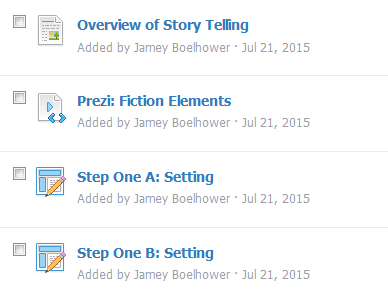Organizing content on a Learning Management System (LMS) is tricky.
The design of the LMS is the first factor you have to contend with. Moodle uses topics, with six different format options. Schoology uses folders. Edmodo uses a feed design. Google Classroom has a stream but connects to Google Drive for material. In this post I will address concepts of organization that you will have to adapt for your LMS.
 Student Paced or Teacher Paced
Student Paced or Teacher Paced
This is the first question to consider because each option has unique aspects that you will have to address when organizing your lessons. Due dates, restrictions, student progress, and work time are just some of the factors involved in deciding if a lesson unit will be set up as student paced or teacher paced. I will focus on the student paced idea for this post.
Student Paced
I know what you are thinking, that the students will slack off, then rush to do all (or just enough of) the activities the day they are due. A student paced lesson can be an empowering learning experience for students if it is organized well. Let’s look at some main factors and how they interact with an LMS for student paced.
Due Dates and Progress
When designing a student paced unit you need to consider how much time students will need to complete the unit. Just like assignments, for most LMSs you can create an open and close date for folders or topics (in most cases you can set an open / close date for any digital element you have in your lesson).
Next, though, is the cool part. For student paced lessons you can design the content or next step to open only if certain criteria have been met, like a passing grade or viewing a video. In Schoology this option is called, “Student Progress.” Moodle has “Restrict Access” options.
The basic idea is that you decide on the order of the content, or what steps the students need to follow to complete the unit of study. The next design question is what rules you want to have in place to guide the student through the lesson. Below is an example from part of my creative writing unit on Schoology.

Without getting deep into the process, I set up the unit to be student paced. The students had to view, “Overview of Story Telling,” then the Prezi would be visible for the students. Once they viewed that, “Step One A: Setting” was ready for them to complete. For “Step One B: Setting” to open students had to receive a passing grade on “Step One A: Setting.” (I recognize that I need to rework the titles of these assignments.)
Designing a unit to be student paced takes extra time. But that time is gained back by allowing you more time in the classroom to interact with students.
The next design component is layout.
Layout affects teacher paced curriculum more than student paced, but is important nonetheless. Here is where the design of your LMS may force you to adapt your ideas, so be prepared for that hurdle.
At the heart of this element is choosing between time or topic organization. Whether your LMS has folders, a feed, or topic blocks, designing how the content will be organized makes it easier for the students to complete the objectives. I have seen too many shotgun approaches in an LMS. There is folders, links, assignments, and other material all over the page of an LMS. This causes frustration for the students and you. Let’s look at the basics of time and topic based organization.
Time
The most common way to organize the digital aspect of your lesson is by week. Again, your LMS influences how this works, but basically, you organize a folder or block with all the digital material you will cover in a week. My ENG Comp 1010 class is organized by week. The students see each block labeled, “Week 1”, “Week 2”, etc. Inside the block is all the digital material they will interact with during the week.
But you can decide on what time window you want to use. That is the cool part of an LMS. With a little planning, you can organize your class in anyway possible. Your class can be organized by months, days, or even semesters.
Topic
Organized by topic or unit of study may be the most popular. Time is still a factor, especially with assignments, but the unit is designed with a resource feel. Below is an example of my unit for the book Lord of the Flies. The main folder is labeled “Lord of the Flies” and this is the first level look the students have to the folder. Inside each folder is specific content correlating to the folder’s label.

The most important aspect of organizing the content is to allow the student to navigate through the digital content to have the best learning experience. The next post will build on that idea of navigating through your class on an LMS. Feel free to contact me with questions or ideas.
Would you say that student-paced training is usually better? Or is it just a matter of a particular group?
LikeLike
One factor of student paced units I like is the ability for the students to take more responsibility for their learning. Yes, I have had students wait to till the end and rush their work. But, I hardly ever had “late” work when the unit was student paced. It also created a flipped classroom feel. I spent time answering questions and helping with tech issues. I had to be on my toes because students would be working on different assignments. I wouldn’t say it is better in a blanket way. But it has advantages for certain objective or units of study.
LikeLike
Thank you for elaborating! I’d also say that it’s got that novelty feel, which isn’t a bad thing at all.
LikeLiked by 1 person